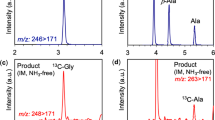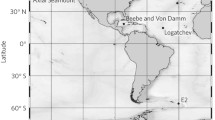Abstract
Prebiotic oceans might have contained abundant amino acids, and were subjected to meteorite impacts, especially during the late heavy bombardment. It is so far unknown how meteorite impacts affected amino acids in the early oceans. Impact experiments were performed under the conditions where glycine was synthesized from carbon, ammonia, and water, using aqueous solutions containing 13C-labeled glycine and alanine. Selected amino acids and amines in samples were analyzed with liquid chromatography-mass spectrometry (LC/MS). In particular, the 13C-labeled reaction products were analyzed to distinguish between run products and contaminants. The results revealed that both amino acids survived partially in the early ocean through meteorite impacts, that part of glycine changed into alanine, and that large amounts of methylamine and ethylamine were formed. Fast decarboxylation was confirmed to occur during such impact processes. Furthermore, the formation of n-butylamine, detected only in the samples recovered from the solutions with additional nitrogen and carbon sources of ammonia and benzene, suggests that chemical reactions to form new biomolecules can proceed through marine impacts. Methylamine and ethylamine from glycine and alanine increased considerably in the presence of hematite rather than olivine under similar impact conditions. These results also suggest that amino acids present in early oceans can contribute further to impact-induced reactions, implying that impact energy plays a potential role in the prebiotic formation of various biomolecules, although the reactions are complicated and depend upon the chemical environments as well.









Similar content being viewed by others
References
Martins, Z., Sephton, M.A.: Extraterrestrial amino acids. In: Hughes, A.B. (ed.) Amino Acids, Peptides in Organic Chemistry, pp. 3–42. Wiley-VCH Verlag GmbH & Co. KGaA, Weinheim (2009)
Elsila, J.E., Glavin, D.P., Dworkin, J.P.: Cometary glycine detected in samples returned by Stardust. Meteor. Planet. Sci. 44, 1323–1330 (2009)
Miller, S.L.: A production of amino acids under possible primitive earth conditions. Science 117, 528–529 (1953)
Kasting, J.F., Howard, M.T.: Atmospheric composition and climate on the early Earth. Phil. Trans. R. Soc. 361, 1733–1742 (2006)
Cleaves, H.J., Chalmers, J.H., Lazcano, A., Miller, S.L., Bada, J.L.: A reassessment of prebiotic organic synthesis in neutral planetary atmospheres. Org. Life Evol. Biosph. 38, 105–115 (2008)
Nakazawa, H., Sekine, T., Kakegawa, T., Nakazawa, S.: High yield shock synthesis of ammonia from iron, water and nitrogen available on the early Earth. Earth Planet. Sci. Lett. 235, 356–360 (2005)
Culler, T.S., Becker, T.A., Muller, R.A., Renne, P.R.: Lunar impact history from 40Ar/39Ar dating of glass spheres. Science 287, 1785–1788 (2000)
Valley, J.W., Peck, W.H., King, E.M., Wilde, S.A.: A cool early Earth. Geology 30, 351–354 (2002)
Nakazawa, H.: The Origin of Life: a Scenario Written by the Earth. Shin-Nihon Publ. Co. Tokyo (2006)
Hennet, R.J.C., Holm, N.G., Engel, M.H.: Abiotic synthesis of amino acids under hydrothermal conditions and the origin of life: a perpetual phenomenon. Naturwissenschaften 79, 361–365 (1992)
Marshall, W.L.: Hydrothermal synthesis of amino acids. Geochim. Cosmochim. Acta 58, 2099–2106 (1994)
Huber, C., Wächtershäuser, G.: α-hydroxy and α-amino acids under possible hadean, volcanic origin-of-life conditions. Science 314, 630–632 (2006)
Aubrey, A.D., Cleaves, H.J., Bada, J.L.: The role of submarine hydrothermal systems in the synthesis of amino acids. Orig. Life Evol. Biosph. 39, 91–108 (2009)
Furukawa, Y., Sekine, T., Oba, M., Kakegawa, T., Nakazawa, H.: Biomolecule formation by oceanic impacts on early Earth. Nat. Geosci. 2, 62–66 (2009)
Furukawa, Y., Samejima, T., Nakazawa, H., Kakegawa, T.: Experimental investigation of reduced volatile formation by high-temperature interactions among meteorite constituent materials, water, and nitrogen. Icarus 231, 77–82 (2014)
Goldman, N., Reed, E.J., Fried, L.E., Kuo, I.F.W., Maiti, A.: Synthesis of glycine-containing complexes in impacts of comets on early Earth. Nat. Chem. 2, 949–954 (2010)
Otake, T., Taniguchi, T., Furukawa, Y., Nakazawa, H., Kakegawa, T.: Stability of amino acids and their oligomerization under high-pressure conditions: implications for prebiotic Chemistry. Astrobiology 11, 799–813 (2011)
Ohara, S., Kakegawa, T., Nakazawa, H.: Pressure effects on the abiotic polymerization of glycine. Orig. Life Evol. Biosph. 37, 215–223 (2007)
Furukawa, Y., Otake, T., Ishiguro, T., Nakazawa, H., Kakegawa, T.: Abiotic formation of valine peptides under conditions of high temperature and high pressure. Orig. Life Evol. Biosph. 42, 519–531 (2012)
Paterson, E., Horz, F., Chang, S.: Modification of amino acids at shock pressures of 3.5 to 32 GPa. Geochim. Cosmochim. Acta 61, 3937–3950 (1997)
Bertrand, M., van der Gaast, S., Vilas, F., Hörz, F., Haynes, G., Chabin, A., Brack, A., Westall, F.: The fate of amino acids during simulated meteoritic impact. Astrobiology 9, 943–951 (2009)
Blank, J.G., Miller, G.H., Ahrens, M.J., Winans, R.E.: Experimental shock chemistry of aqueous amino acid solutions and the cometary delivery of prebiotic compounds. Org. Life Evol. Biosph. 31, 15–51 (2001)
Chen, J., Cheng, H., Zhu, X., Jin, L., Zheng, H.: In situ transformation of an aqueous amino acid at high pressures and temperatures. Geochem. J. 41, 283–290 (2007)
Basiuk, V.A., Douda, J.: Pyrolysis of simple amino acids and nucleobases: survivability limits and implications for extraterrestrial delivery. Planet Space Sci 47, 577–584 (1999)
Chareonpanich, M., Takeda, T., Yamashita, H., Tomita, A.: Catalytic hydrocracking reaction of nascent coal volatile matter under high pressure. Fuel 73, 666–670 (1994)
Brack, A.: Clay minerals and origin of life. In: Bergaya, G., Theng, B.K.G., Lagaly, G. (eds.) Handbook of Clay Science, pp. 379–391. Elsevier, Amsterdam (2006)
Cleaves, H.J., Pregont, E.C., Jonsson, C.M., Jonsson, C.L., Sverjensky, D.A., Hazen, R.A.: The adsorption of short single-stranded DNA oligomers to mineral surfaces. Chemosphere 83, 1560–1567 (2011)
Bada, J.L.: Amino acid cosmogeochemistry. Phil. Trans. R. Soc. Lond. 333, 349–358 (1991)
Dymek, R.F., Klein, C.: Chemistry, petrology and origin of banded iron-formation lithologies from the 3800 Ma Isua supracrustal belt, West Greenland. Precambrian Res. 39, 247–302 (1988)
Christensen, P.R., Bandfield, J.L., Clark, R.N., Edgett, K.S., Hamilton, V.E., Hoefen, T., Kieffer, H.H., Kuzmin, R.O., Lane, M.D., Malin, M.C., Morris, R.V., Pearl, J.C., Pearson, R., Roush, T.L., Ruff, S.W., Smith, M.D.: Detection of crystalline hematite mineralization on Mars by the Thermal Emission Spectrometer: Evidence for near-surface water. J. Geophys. Res. 105, 9623–9642 (2000)
Ohtomo, Y., Kakegawa, T., Ishida, A., Nagase, T., Rosing, M.T.: Evidence for biogenic graphite in early Archaean Isua metasedimentary rocks. Nat. Geosci. 7, 25–28 (2014)
McKay, D.S., Gibson Jr., E.K., Thomas-Keprta, K.L., Vali, H., Romanek, C.S., Clemett, S.J., Chillier, X.D.F., Maechling, C.R., Zare, R.N.: Search for past life on mars: possible relic biogenic activity in Martian meteorite ALH84001. Science 273, 924–930 (1996)
Sekine, T.: Shock wave chemical synthesis. Eur. J. Solid State Inorg. Chem. 34, 823–833 (1997)
Marsh, S.P.: LASL Shock Hugoniot Data. Univ. California Press, Los Angeles (1980)
Williamson, G.K., Hall, W.H.: X-ray line broadening from filed aluminium and wolfram. Acta Metall. 1, 22–31 (1953)
Furukawa, Y., Sekine, T., Kakegawa, T., Nakazawa, H.: Impact-induced phyllosilicate formation from olivine and water. Geochim. Cosmochim. Acta 75, 6461–6472 (2011)
Robie, R.A., Hemmingway, B.S., Fisher, J.R.: Thermodynamic properties of minerals and related substances at 298.15 K and 1 bar (105 Pascals) pressure and at higher temperature. United States Government Printing Office, Washington (1995)
Koel, B.E., Crowell, J.E., Bent, B.E., Mate, C.M., Somorjai, G.A.: Thermal decomposition of benzene on the Rh (111) crystal surface. J. Phys. Chem. 90, 2949–2956 (1986)
Gunanathan, C., Milstein, D.: Selective synthesis of primary amines directly from alcohols and ammonia. Angew. Chem. Int. Ed. 47, 8661–8664 (2008)
McEnally, C.S., Ciuparu, D.M., Pfefferle, L.D.: Experimental study of fuel decomposition and hydrocarbon growth processes for practical fuel components: heptanes. Combust. Flame 134, 339–353 (2003)
Dixon, C.N., Abraham, M.A.: Conversion of methane to methanol by catalytic supercritical water oxidation. J. Supercrit. Fluids 5, 269–273 (1992)
Sato, N., Quitain, A.T., Kang, K., Daimon, H., Fujie, K.: Reaction kinetics of amino acid decomposition in high-temperature and high-pressure water. Ind. Eng. Chem. Res. 43, 3217–3222 (2004)
Klingler, D., Berg, J., Vogel, H.: Hydrothermal reactions of alanine and glycine in sub- and supercritical water. J. Supercrit. Fluids 43, 112–119 (2007)
Fox, S.W., Windsor, C.R.: Synthesis of amino acids by the heating of formaldehyde and ammonia. Science 170, 984–986 (1970)
Reid, C.: In: Oparin, A.I., Pasynski, A.G., Braunstein, A.E., Pavlovskaya, T.E. (eds.) The origin of Life on the Earth, pp. 619–625. Pergamon, London (1959)
Alargov, D.K., Deguchi, S., Tsujii, K., Horikoshi, K.: Reaction behaviors of glycine under super- and subcritical water conditions. Orig. Life Evol. Biosph. 32, 1–12 (2002)
McCollom, T.M.: The influence of minerals on decomposition of the n-alkyl-α-amino acid norvaline under hydrothermal conditions. Geochim. Cosmochim. Acta 104, 330–357 (2013)
Sugahara, H., Mimura, K.: Glycine oligomerization up to triglycine by shock experiments simulating comet impacts. Geochem. J. 48, 51–62 (2014)
Islam, M.N., Kaneko, T., Kobayashi, K.: Reaction of amino acids in a supercritical water-flow reactor simulating submarine hydrothermal systems. Bull. Chem. Soc. Jpn. 76, 1171–1178 (2003)
Andersson, E., Holm, N.G.: The stability of some selected amino acids under attempted redox constrained hydrothermal conditions. Orig. Life Evol. Biosph. 30, 9–23 (2000)
Bada, J.L., Miller, S.L., Zhao, M.: The stability of amino acids at submarine hydrothermal vent temperature. Orig. Life Evol. Biosph. 25, 111–118 (1995)
Harberstroh, P.R., Karl, D.M.: Dissolved free amino acids in hydrothermal vent habitats of the Guayman Basin. Geochim. Cosmochim. Acta 53, 2937–2945 (1989)
Blank, J.G., Miller, G.H.: The fate of organic compounds in cometary impacts. Proc. 21st Intern. Symp. Shock Waves, edited by A. Houwing et al., p. 8180 (1998)
Zhang, F., Sekine, T.: Impact-shock behavior of Mg- and Ca-sulfates and their hydrates. Geochim. Cosmochim. Acta 71, 4125–4133 (2007)
Gilvarry, J.J., Hochstim, A.R.: Possible role of meteorites in the origin of life. Nature 197, 624–625 (1963)
Bar-Nun, A., Bar-Nun, N., Bauer, S.H., Sagan, C.: Shock synthesis of amino acids in simulated primitive environments. Science 168, 470–473 (1970)
Bar-Nun, A., Shaviv, A.: Dynamic of the chemical evolution of Earth’s primitive atmosphere. Icarus 24, 197–210 (1975)
Acknowledgments
The TEM and SEM observations were performed at N-BIRD, Hiroshima University. We thank K. Shibata and M. Maeda for their help. This research was supported in part by grants from JSPS (24244084 to TK, 23740402 to YF, and 24654176 to TS). We are thankful to Kausik Das for improvement of our early manuscript.
Author information
Authors and Affiliations
Corresponding author
Rights and permissions
About this article
Cite this article
Umeda, Y., Fukunaga, N., Sekine, T. et al. Survivability and reactivity of glycine and alanine in early oceans: effects of meteorite impacts. J Biol Phys 42, 177–198 (2016). https://doi.org/10.1007/s10867-015-9400-5
Received:
Accepted:
Published:
Issue Date:
DOI: https://doi.org/10.1007/s10867-015-9400-5




